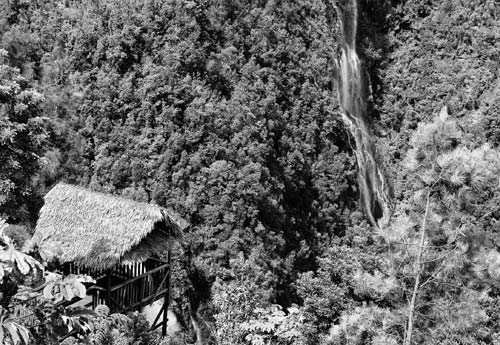
S PLAYAS LA HERRADURA AND LA BOCA
Holguín to Guantánamo Province
S MUSEO CONJUNTO HISTÓRICO BIRÁN
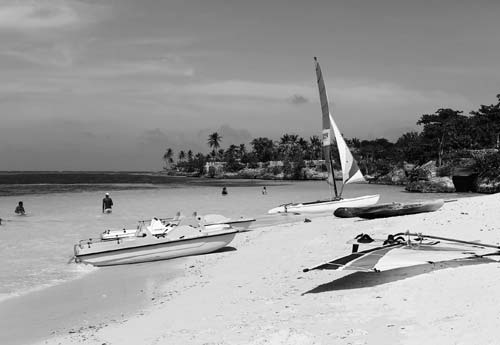
Rich in history and physically diverse, this region is as interesting as any in the nation. Holguín, rather than Las Tunas, steals the show.
Las Tunas Province forms a flat, narrow band across the island, broadening to the northeast. The capital city occupies a low-lying ridge on the eastern edge of the great plains that dominate central Cuba. It is dull, unvarying terrain, mostly farmed for cattle. The scenery begins to grow more lush and interesting eastward. The province has few beaches, but Playa Herradura is a stunner popular with Cubans and as-yet-undiscovered by foreign visitors. There are few sites of interest other than in the eponymous provincial capital.
Holguín, by contrast, is chock-full of things to see and do. The capital city itself boasts several colonial plazas and an active nightlife, and the hinterlands have several unique sites, foremost among them Fidel Castro’s birthplace. Holguín’s north-central shore is in the throes of touristic development, centered on Playas Guardalavaca and Pesquero. Inland, the dramatic formations of the Grupo de Maniabon will have you reaching for your camera, and there are pre-Columbian museums and archaeological sites to explore.
East of Holguín city, the coastal plain narrows down to a panhandle extending along the shore at the base of the Sierra de Nipe, Sierra del Cristal, Cuchillas del Toa, and Alturas de Moa. These mountains are nirvana to bird-watchers and hikers. The color of heated chrome, the mountains are also rich in cobalt, manganese, and nickel. The ores are processed at the coastal town of Moa, in the far east of Holguín Province; the immediate area is blighted by the mineral extraction industry.
The city of Las Tunas is worth a quick browse in passing. All routes through the province pass through the capital. The larger city of Holguín offers considerably more to see, including three plazas. Holguín also has a well-developed cultural scene, with everything from an excellent Casa de la Cultura to a bargain-priced cabaret. I recommend a two-day stay.
The slightly down-at-heels seafront town of Gibara appeals for its marvelous setting, laid-back lifestyle, and bracing ocean airs. It has an excellent natural history museum. To its west, I love Playa Herradura—probably the nicest beach in Cuba for sharing a 100 percent Cuban experience.
The Parque Monumento Nacional Bariay, where Christopher Columbus supposedly first set foot on Cuban soil in 1492, is strongly touted for a half-day visit, with most participants buying into package excursions from the nearby beach resorts. Far more rewarding is the Museo Aborigen Chorro de Maíta, a pre-Columbian archaeological site, and the similarly focused Museo Indocubano, in Banes. And how about Museo Conjunto Histórico Birán, Fidel Castro’s birthplace and childhood home?
The beach resort of Guardalavaca and nearby Playa Pesquero are imbued with all-inclusive resorts plus plenty of options for trippers on day visits from Holguín, including scuba diving, a dolphin show, bird-watching, horseback riding, and kayaking. You can even take a ride into the Grupo de Maniabon in a 1920 Baldwin steam train.
Birders and hikers should head for Pinares de Mayarí, an alpine retreat in the Sierra de Nipe, where the Salto El Guayabo waterfall is not to be missed, or to Cayo Saetía, where the wildlife-viewing is surreal (think camels and zebra).
The Carretera Central cuts through the center of the provinces. At Holguín, it turns southwest for Bayamo, in Granma Province. If heading from Camagüey direct to Granma Province and Santiago, you can bypass Holguín via a paved road that leads southeast from Las Tunas to Bayamo and cuts across the Río Cauto plains via the town of Jobabo.
The Circuito Norte (north coast road) is disjointed and diverts you inland through the cities of Las Tunas and Holguín. Roads radiate to Puerto Padre, Gibara, Guardalavaca, and Banes. West of Manatí and east of Moa, much of the Circuito Norte is badly deteriorated.
Las Tunas (pop. 80,000) is a small-time capital of a small-time province. The town is officially known as La Victoria de las Tunas, a name bequeathed by the Spanish governor in 1869 to celebrate a victory in the Ten Years War. Patriots under General Vicente García recaptured the town in 1895. Two years later, it was put to the torch by rebels as Spanish forces attempted to retake it. Thus the town today lacks edifices of architectural note.
Las Tunas (nicknamed “City of Sculptures”) is famed for its terra-cotta ceramics, expressed in contemporary art scattered all over the city. Look for works by some of Cuba’s leading artists, such as Liberation of the People by Manuel Chong, opposite the Asamblea Provincial.
The town sits astride the Carretera Central, which enters from the west along Avenida 1ro de Enero, becomes Avenida Vicente García, and slopes up to the central square—Parque Vicente García—where it turns 90 degrees and runs southeast for Holguín as Calle Francisco Verona. A circunvalación bypasses the town.
The historic core is laid out in a grid centered on Parque García, at the top of Vicente García, between Calles Francisco Varona and Francisco Vega. Frank País runs northeast to the railway station, where it forks for the airport and Puerto Padre, on the north coast.
The Museo de Mártires de Barbados (Luca Ortíz #344, tel. 031/34-7213, Tues.-Sat. 11am-7pm, Sun. 8am-noon, free), at the base of Vicente García, occupies a small wooden house where lived Carlos Leyva González, Cuba’s champion florete (fencer). Leyva died, along with his brother and the entire Cuban fencing team, when Cubana flight CU-455 was destroyed by a bomb after taking off from Barbados on October 6, 1976. All 73 people aboard died, including 57 Cubans, 5 Koreans, and 11 Guyanese. Right-wing Cuban-American exiles Otto Bosch and Luis Posada Carilles were convicted. Bosch was pardoned by President George H. W. Bush, and Posada, who escaped prison in Venezuela and lives a free man in Miami, is hailed as a hero by extremist Cuban-Americans.
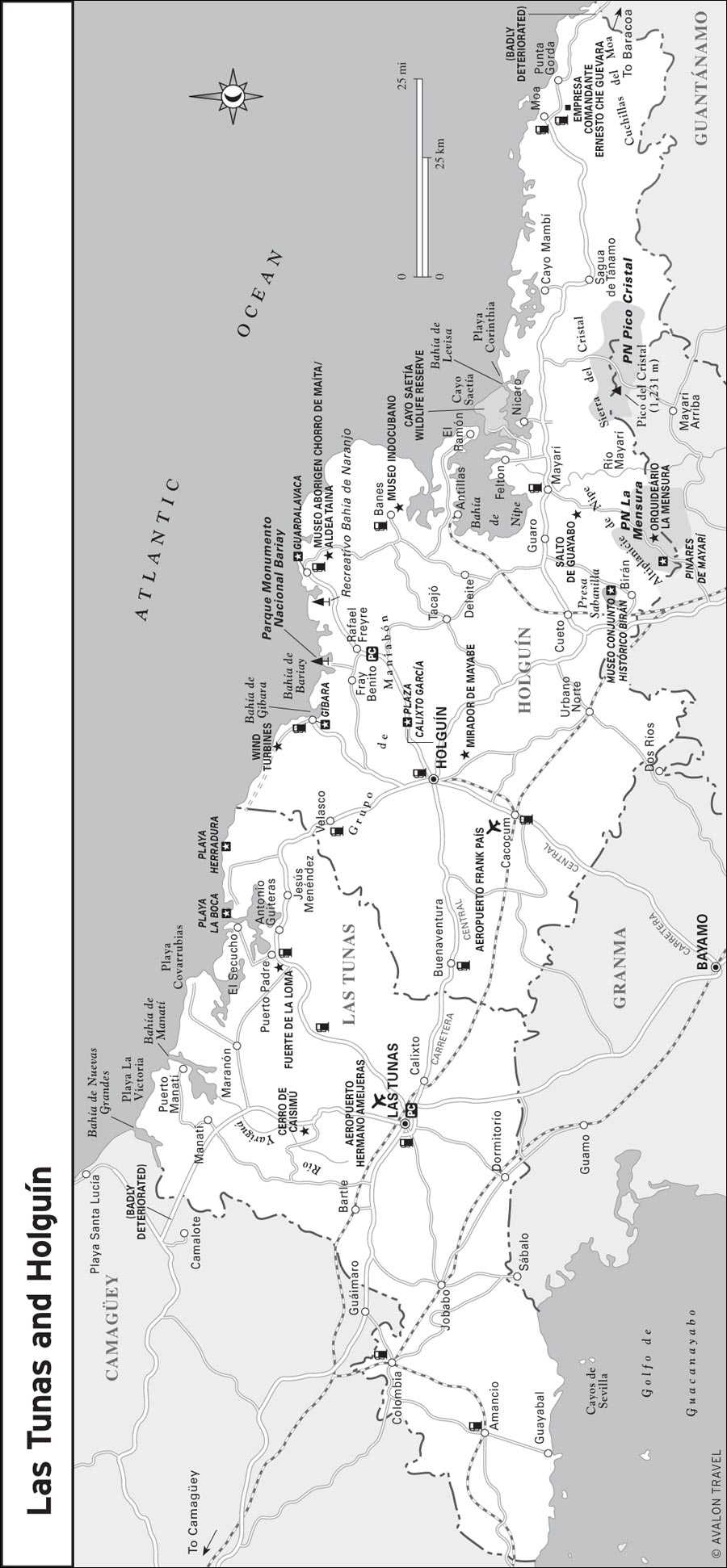
Note the dramatic sculpture of an arm and clenched fist (like a fencer’s clutching a foil) made from wreckage of the doomed aircraft.
The town’s main square, at the top of Avenida Vicente García, features a marble statue of the local hero, Major General Vicente García González, who burned the city rather than let it fall into Spanish hands. On the southwest corner is a small church. On the park’s northeast corner, separated by Calle Colón, is the petite Plaza Martiana de las Tunas, with a contemporary sculpture of José Martí and a massive sundial.
The Centro Histórico (Francisco Verona, esq. Vicente García, tel. 031/34-8201), on the northwest corner, features meager exhibits on local history. Note the ceramic bas-relief map of the city on its wall. Catercorner, the Museo Provincial (Francisco Varona and Vicente García, tel. 031/34-8201, Tues.-Thurs. 8:30am-4:30pm, Fri.-Sat. 11am-7pm, Sun. 8am-noon, free) has eclectic exhibits on local history and culture, including 10-syllable rhyming songs called décimas. Another room is dedicated to internacionalismo—Cuba’s support for revolutionary causes throughout the world. Upstairs the natural history room has a whale skeleton.
One block south of the park, Casa del Vicente García González (Vicente García #5, tel. 031/34-5164, Tues.-Sat. 9am-6pm, Sun. 8am-noon, CUC1) is where, on September 26, 1876, General Vicente García purportedly began the fire that burned the city. The building, which miraculously survived, is now a museum commemorating the wars of independence.
The ungainly Revolution Plaza, on the northeast side of town, is dominated by the huge Monumento a Mayor General Vicente García González, hewn in pink concrete with bas-reliefs showing the local hero of the wars of independence with his sword held high. The Salón de los Generales features bronze busts of other generals in the wars.
The Feria Interprovincial agricultural fair in mid-February features rodeos in Parque 26 de Julio, at the base of Vicente García. Las Tunas hosts a carnival in September, plus the Jornada Cucalambeana (Cucalambé Folkloric Festival, tel. 031/34-7770), when songsters from all parts of Cuba compete with décimas (impromptu poems). It takes place at Motel El Cornito (tel. 031/34-5015), 10 kilometers west of town, each June or July.
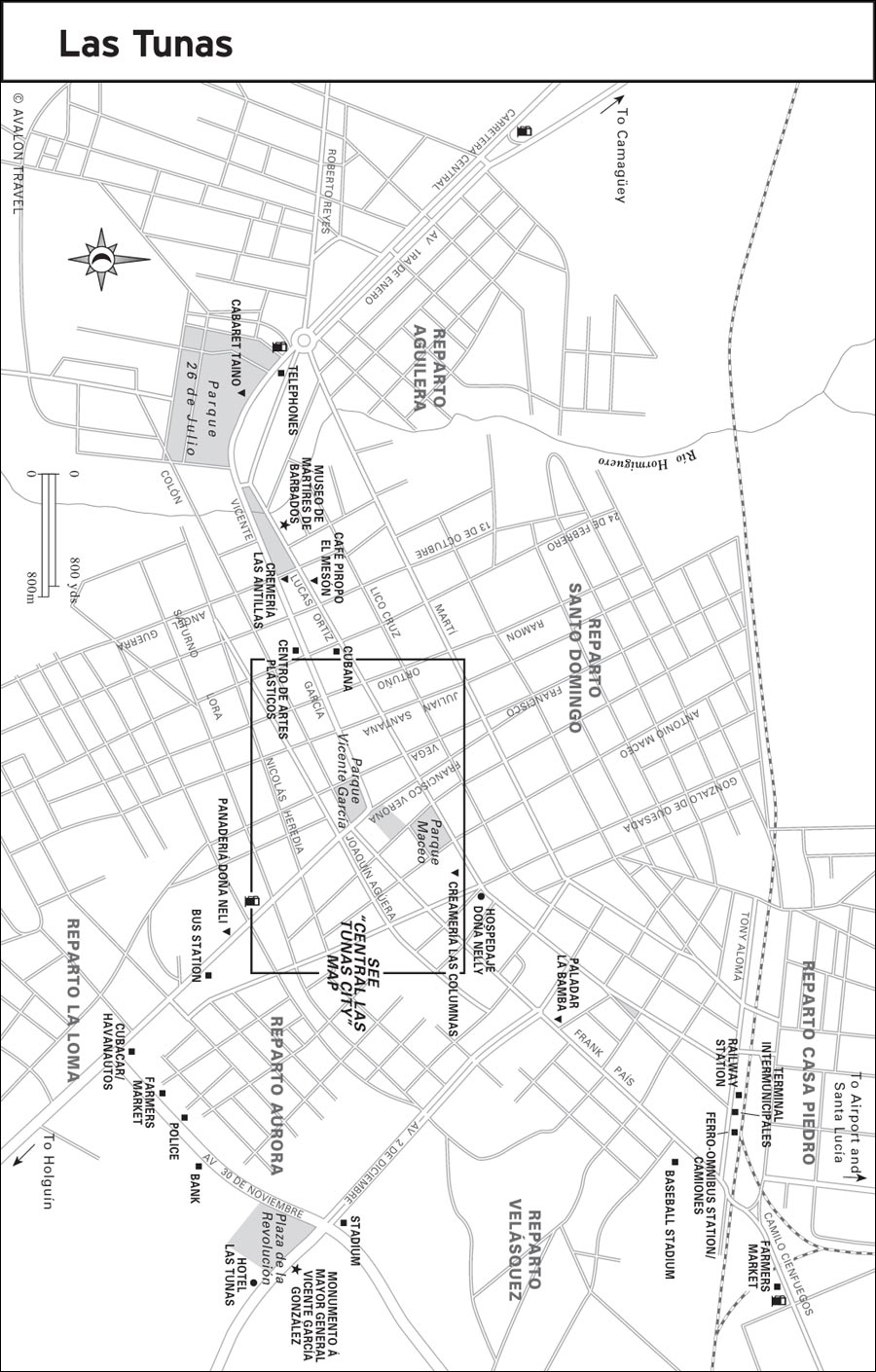
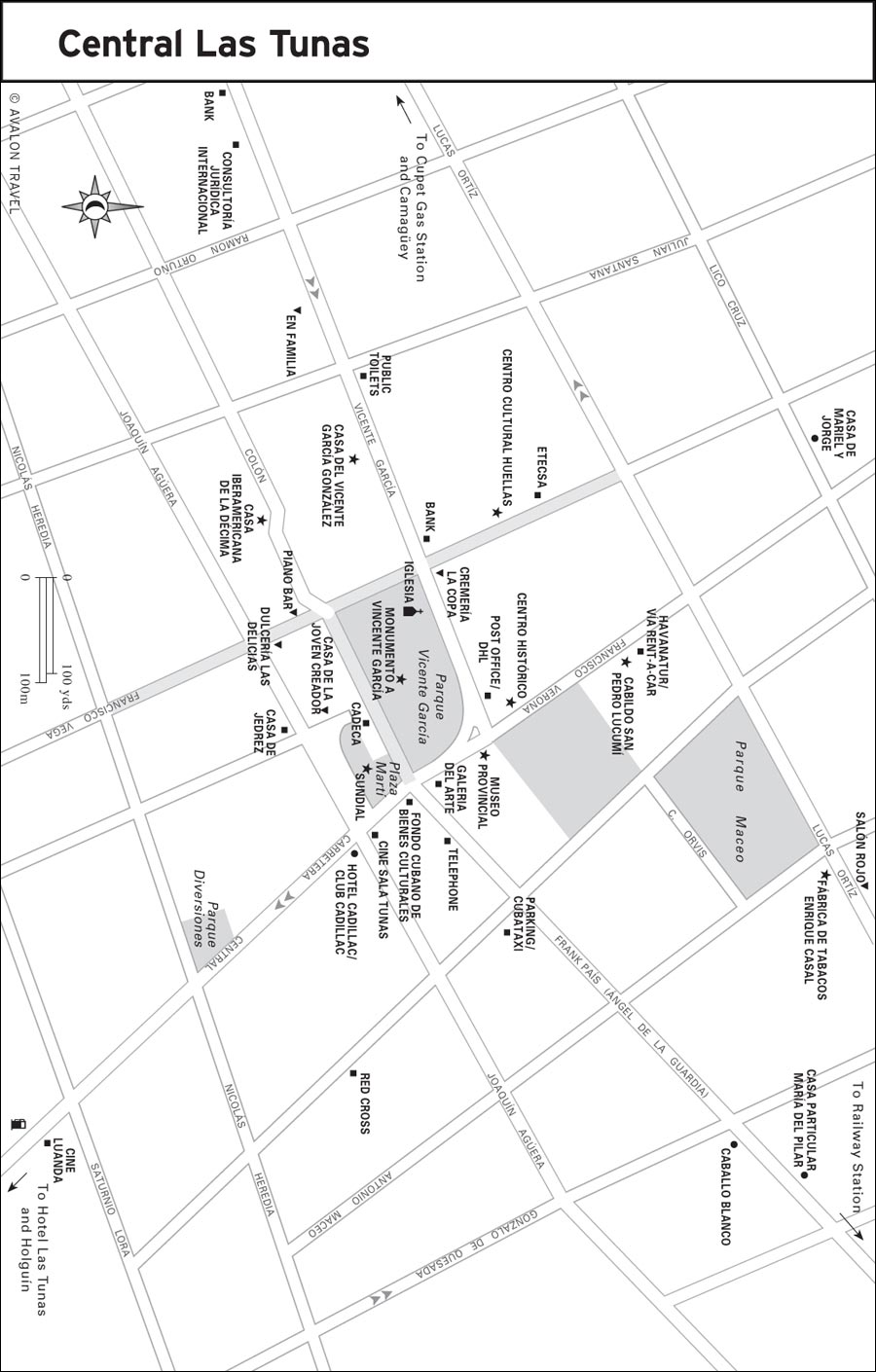
At all times of year, the Casa Iberoamericana de la Décima (Calle Colón #161, e/ Francisco Vega y Julian Santana, tel. 031/34-7380, cdecima@tunet.cult.cu) has daily poetry recitals and peñas.
Culture vultures can also get a fix of poetry and live music at Centro Cultural Huellas (Calle Francisco Vegas e/ Luca Ortíz y Vicente García, Mon.-Fri. 9am-5pm, Sat. 9am-noon). The Cabildo San Pedro Lucumí (Francisco Verona, e/ Angel Guardia y Lucas Ortíz, tel. 031/34-6461, free) celebrates Afro-Cuban drumming and dance on Sunday at 9pm.
Cabaret Taíno (tel. 031/34-3823), at the base of Vicente García, hosts a cabaret espectáculo Saturday at 9pm (35 pesos).
The hottest salsa scene is Cine Disco Luanda (Carretera Central, esq. Saturno Lora, tel. 031/34-8671, Mon.-Sat. 11pm-3am, Sun. 3pm-8pm, CUC3-5, including drinks), a Western-style disco featuring laser lights. It also has a cinema.
From October to May you can catch a baseball game at Estadio Julio Antonio Mella, at the north end of Avenida 2 de Diciembre.
Near the center, the stand-out is S El Caballo Blanco (Calle Frank País #85, esq. Gonzalo de Quesada, tel. 031/37-3658 or 5281-8264, CUC20 low season, CUC25 high season), where Dr. José Luis Viguero Pavón offers two nicely furnished upstairs rooms with modern bathrooms and a lounge. The best paladar in town is here, too. Casa de María de Pilar (Frank País #82A, e/ Gonzalo de Quesada y Iran Durañeno, tel. 031/34-0467 or 5294-7078, mariadelpilar412@yahoo.es, CUC25) is a lovely modern home with two pleasant rooms and parking.
I’ve twice stayed at Hospedaje Doña Nelly (Lucas Ortíz #111, e/ Gonzalo de Quesada y Coronel Fonseca, tel. 031/34-2526, cl8rbt@frcuba.co.cu, CUC20-25), a large colonial home with a piano in the lounge, plus an air-conditioned room with a private bathroom. Laundry service is offered.
Casa de Maribel y Jorge (Lico Cruz #188, e/ Francisco Varona y Francisco Vega, tel. 031/34-5533, CUC20-25) has two well-lit, air-conditioned rooms with fans, TVs, and modern bathrooms.
If nondescript neo-Stalinist prefab hotels are your thing, check into Islazul’s Hotel Las Tunas (tel. 031/34-5014, reservas@hotellt.co.cu, CUC21 s, CUC30 d low season, CUC27 s, CUC43 d high season), one kilometer east of town on Avenida de 2 Diciembre. It has 142 no-frills air-conditioned rooms.
The art deco Hotel E Cadillac (Joaquín Agüero esq. Francisco Verona, tel. 031/37-2791, www.islazul.cu, CUC25 s, CUC35 d low season, CUC40 s, CUC50 d high season), built in 1945 in the shape of a slanting, rounded prow with pothole windows, has been rehashed and has eight rooms and two suites with plasma TVs, modern bathrooms, and cheap modern furniture.
The best private dining option is S El Caballo Blanco (Calle Frank País #85, esq. Gonzalo de Quesada, tel. 031/34-2586, daily 10am-11pm), a superb paladar set in a travertine-clad patio with open-air bar. The menu includes chicken with wine (CUC2.50), garlic shrimp (CUC2.75), and a superb ropa vieja (CUC2).
Paladar El Balcón (Calle Fernando Suárez #14, tel. 031/34-9312, daily 8am-midnight, CUC5) serves huge portions on a shaded patio or in charmless rooms. Paladar La Bamba (Ángel de la Guardia y 2 de Diciembre, no tel., daily 8am-10pm) has dining under thatch. I recommend the rabbit enchilada (CUC3.50).
You can buy ice cream for pesos at Cremería La Copa (daily 9am-3:30pm and 430pm-10pm), on the west side of Parque Vicente García, and Cremería Las Antillas (Vicente García, esq. Ángel Guerra, Mon.-Fri. 10am-11pm, Sat.-Sun. 10am-midnight).
For baked goods, head to Panadería Doña Neli (Carretera Central, daily 7am-10pm), next to the Oro Negro gas station. The mercado agropecuario on Camilo Cienfuegos, 200 meters north of the railway station, sells produce.
Bandec (Av. 30 de Noviembre as well as Vicente García #69), Banco Financiero Internacional (Vicente García, esq. 24 de Octubre), and Banco Popular (Vicente García, esq. Francisco Vega) have branches.
The post office (Vicente García #6, tel. 031/34-3863), on the west side of Parque García, has DHL service. Etecsa (Francisco Varona, e/ Lucas Ortí and Vicente García, daily 8am-7pm) has international telephone and Internet service.
Hospital Che Guevara (Av. Carlos J. Finlay, esq. Av. 2 de Diciembre, tel. 031/34-5012) is 400 meters east of Plaza de la Revolución.
The Consultoría Jurídica Internacional (Vicente García, e/ 24 de Febrero y Ramón Ortuño, tel./fax 031/34-6845, Mon.-Fri. 8:30am-noon and 1:30pm-5:30pm) offers legal assistance.
The Aeropuerto Hermano Ameijeras (tel. 031/34-2484) is three kilometers north of town. Cubana (Lucas Ortíz, esq. 24 de Febrero, tel. 031/34-6872) serves Las Tunas from Havana.
The Terminal de Ómnibus (tel. 031/34-3060 interprovincial buses, tel. 031/34-2117 intermunicipal buses) is on the Carretera Central, one kilometer east of Parque Vicente García. Víazul buses (tel. 031/43060, www.viazul.com) stop in Las Tunas en route between Havana, Varadero, Trinidad, and Santiago de Cuba.
The train station is at Terry Alomá (e/ Lucas Ortíz y Ángel de la Guardia, tel. 031/34-8146). All trains between Havana and Santiago de Cuba stop in Las Tunas (CUC23 to/from Havana, CUC7 to/from Santiago). A two-car commuter train—ferro-ómnibus—runs to towns throughout the province.
You can rent cars from Havanautos (tel. 031/34-6228), in the Hotel Las Tunas, and Cubacar (Francisco Verona, esq. Av. 30 de Noviembre, tel. 031/37-1505). There are gas stations on the Carretera Central: one about 400 meters west of Parque Lenin and one four blocks east of Parque Vicente García.
For taxis, call Cubataxi (tel. 031/34-2036).
This pleasant port town, about 30 kilometers northeast of Las Tunas, is one of Cuba’s oldest. The settlement first appeared, as Portus Patris, on early 16th-century maps of the New World. During the 19th century, Puerto Padre grew to become Cuba’s most important port for sugar export. It featured prominently in the independence wars, when the Spanish built a fortress, Fuerte de la Loma (Tues.-Sat. 9:30am-4:30pm, Sun. 8:30am-11:30am, CUC1), built in 1875 in medieval style to protect the southern entrance to town. Well-preserved, it still stands atop the hill at the end of Puerto Padre’s central boulevard (Avenida Libertad), pinned by the Monumento Máximo Gómez. The boulevard descends downhill to a lovely park with a bandstand and a statue of the liberty maiden.
Las Tunas’s north coast is lined with beautiful beaches, although the only one with a resort hotel is Playa Covarrubias, a four-kilometer-long strip of white sands with turquoise waters protected by a coral reef. The beach is 22 kilometers north of the rural community of Marañon, 15 kilometers west of Puerto Padre; it’s virtually all scrub and briny pools to each side the whole way. You can buy a day pass (CUC25) to utilize the hotel facilities at Brisas Covarrubias.
Puerto Padre has several private room rentals. My favorite is Casa de Elvis and Migdalia (Calle Paco Cabrera esq. Céspedes, tel. 031/51-3124 or 5834-6419, CUC20-25), on the breeze-swept Malecón. Two simply furnished upstairs rooms open to terraces with rockers facing the sea, and they have clean bathrooms.
Brisas Covarrubias (Playa Covarrubias, tel. 031/51-5530, www.hotelescubanacan.com, from CUC60 s, CUC80 d low season, from CUC80 s, CUC100 d high season) is a tranquil property with 180 spacious rooms furnished in contemporary style; some have king-size beds. The huge freeform pool has a thatched bar and theater, plus there’s a kids’ playground, disco, gym, water sports, and diving. However, you’re out on a limb here!
Etecsa (Av. Libertad #144, e/ Masó y Flor Crombet, tel. 031/51-5316, daily 8am-7pm) has international telephone and Internet service. The Cupet gas station is one block farther south.
The singular not-to-miss spot in Las Tunas Province, this string of gorgeous white beaches is easily reached from the north coast road. About 10 kilometers east of Puerto Padre, you pass through Jesús Menéndez and Loma, where a road leads north eight kilometers via Playa Corelia to Playa La Herradura and, eight kilometers farther west, Playa La Boca. The seas are of stunning hues, made more dramatic by the inland lagoons with flamingos and salt flats. Bring mosquito repellent and avoid the beaches at dawn and dusk.
The beaches are immensely popular with locals on weekends; in fact, Playa Herradura is probably the nicest beach on the island for sharing a purely Cuban experience. A boat for La Boca (one peso) leaves from the wharf at El Secucho, 16 kilometers north of Puerto Padre.
There’s no shortage of room rentals and budget seafood eateries. Options at Playa La Boca include Casa de Jorge and Ana (tel. 031/54-7357 or 5828-3732, CUC25), with a pleasing air-conditioned room with TV and DVD player. There’s a paladar next door.
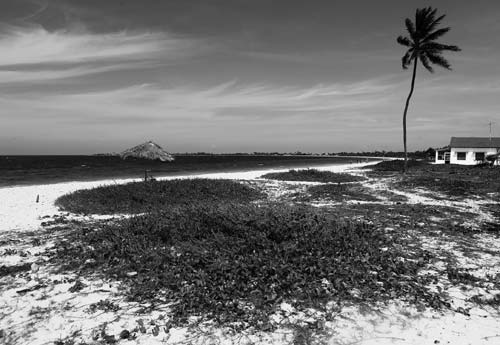
Playa La Boca
At Playa La Boca, the beachfront Villa Carolina (Calle de la Playa, tel. 5238-7272, giuseperradura@gmail.com, http://villacarolinacuba.blogspot.com, CUC25) is run by Gioseppe and Yanet, who offer two spacious bedrooms, each with fan, fridge, and TV.
Holguín (pop. 320,000), 775 kilometers east of Havana and 200 kilometers northwest of Santiago de Cuba, is the fourth-largest city in Cuba. When Columbus landed nearby in 1492, believing he had arrived in Asia, he sent an expedition inland to carry salutations to the Japanese emperor’s court. The explorers came across a large native village called Cubanacán. Three decades later, a land grant was made to Capitán García Holguín, who built a settlement immodestly named for himself.
The colonial core contains many fine houses of Spanish origin. Holguín is renowned for one of the most vibrant cultural scenes in Cuba.
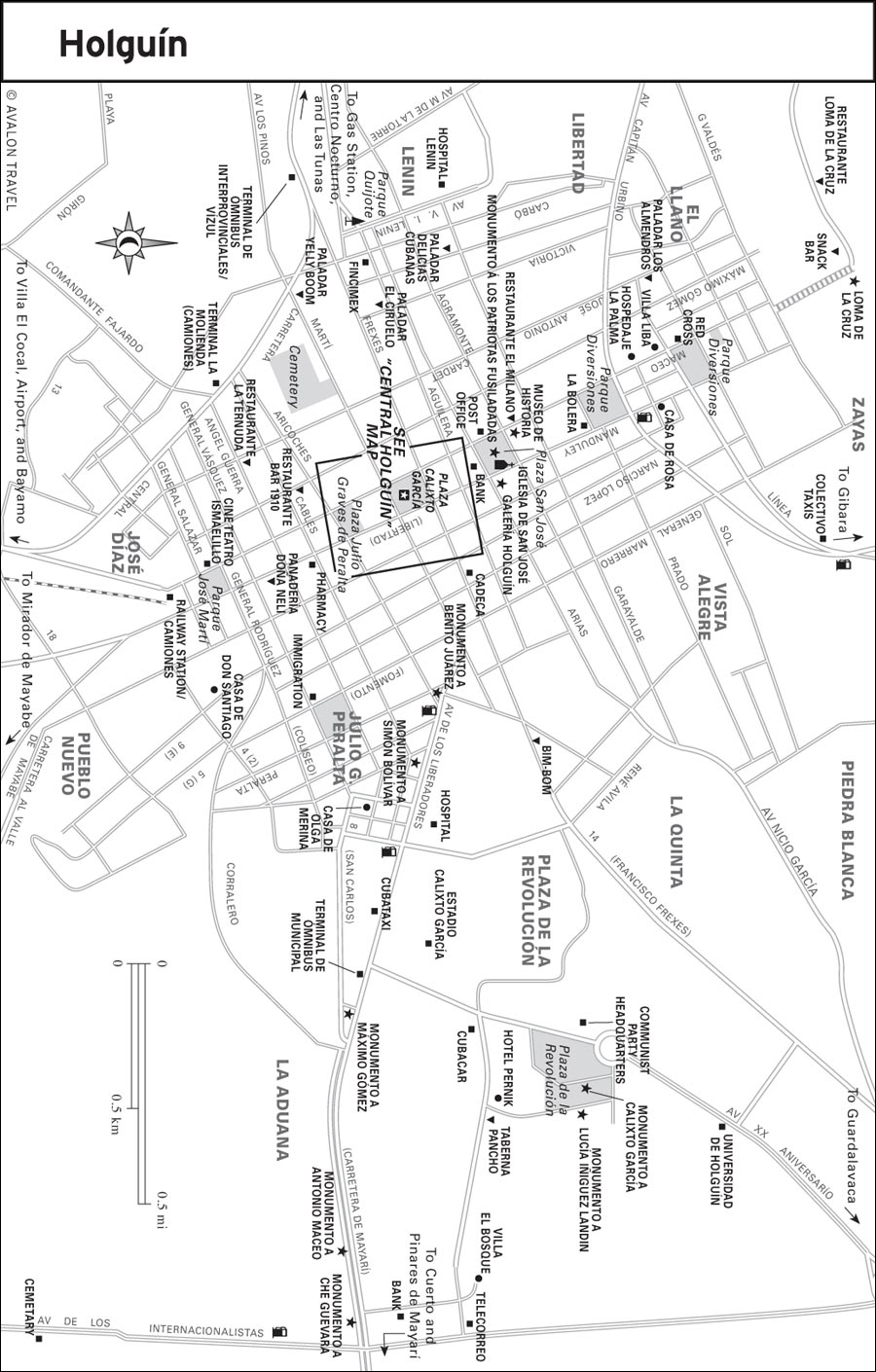
The Carretera Central enters from the west and swings south for Granma Province, skirting the city center. Aguilera (eastbound) and Frexes (westbound) link the Carretera Central to the city center. At its heart is Parque Calixto García, bounded by Calles Frexes (north), Martí (south), Libertad (also known as Manduley; east), and Maceo (west).
Martí runs east from the square and merges to the east with Avenida de los Libertadores, which leads through the modern Plaza de la Revolución district and continues to Moa and Baracoa. The city is bypassed to the south by a circunvalación linking the Carretera Central with the road to Moa.
Libertad runs north from Parque Calixto García to Avenida Capitán Urbino, which leads northeast to Gibara. Avenida XX Aniversario leads northeast to Guardalavaca.
The city’s expansive main square has at its heart a marble Monumento General Calixto García. Holguín’s most famous son was born in the simple Casa Natal de Calixto García (Miró #147, tel. 024/42-5610, Tues.-Sat. 9am-5pm, CUC1), one block east of the square. Some of his personal effects are on view inside the museum.
On the north side, the Museo Provincial de Historia (Frexes #198, tel. 024/46-3395, Tues.-Sat. 8am-4:30pm, Sun. 8am-noon, entrance CUC1, cameras CUC1), with an eclectic range of historical artifacts. It was built 1860-1868 as the Casino Español, where Spanish gentry caroused. It is colloquially known as La Periquera—the Parrot’s Cage—supposedly after Spanish troops in their garish yellow, blue, and green uniforms were trapped inside the building, with its cage-like barred windows, when the town was besieged in 1868 by García’s troops. The museum’s pride and joy is a 35-centimeter-long pre-Columbian axe (the hacha de Holguín) carved in the shape of a human. The axe is the provincial symbol.
The Museo de la Historia Natural Carlos de la Torre (Maceo #129, tel. 024/42-3935, Tues.-Sat. 9am-noon and 12:30pm-5pm, Sun. 9am-noon, CUC1), one block south of the square, is housed in a neoclassical building that was closed for a lengthy restoration at last visit. The museum features an eclectic array of flora and fauna, including a collection of over 4,000 colorful painted snail shells and the near-extinct solenodon. Next door, the Museo Vivo (CUC1) displays live marine denizens in tanks, including the invasive lionfish.
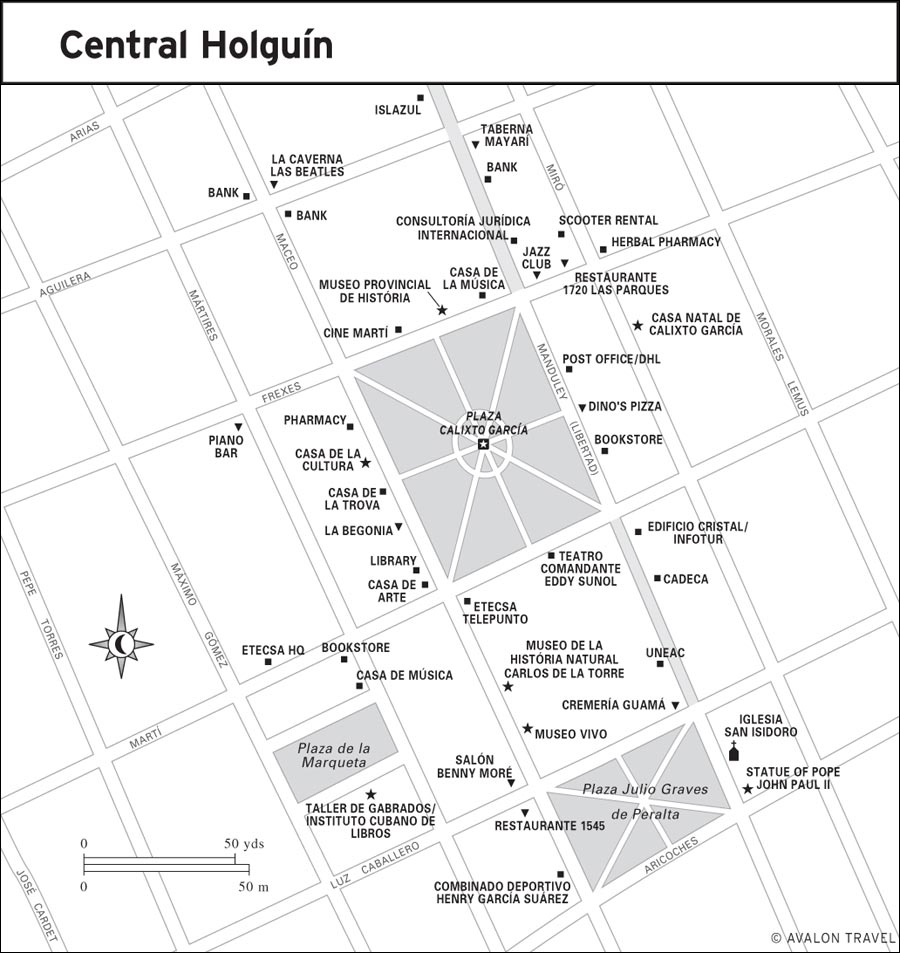
Art lovers should pop into Galería Holguín (Tues.-Sun. 8am-10pm), on the southwest corner.
This small square, four blocks south of Parque Calixto García, is anchored by a marble statue of General Graves de Peralta (1834-1872), who led the rebel assault on October 30, 1868, that captured Holguín from the Spanish.
On the east side, the Iglesia San Isidro dates from 1720 and is named for the town’s patron saint. The wooden ceiling is noteworthy.
The dramatic bas-relief of famous local citizens, called Origenes, on the park’s west side, traces the city’s evolution since pre-Columbian times.
Tiny Plaza de la Marqueta, between Máximo Gómez, Mártires, Martí, and Luz Caballero, occupies the site of a now derelict market and candle factory (marqueta refers to the molds). Deteriorated life-size figures of local personalities dot the square. The Instituto Cubano de Libros print shop (Callejón de Mercado #2, tel. 024/42-4051), on the south side, still makes books using Linotype.
Plaza José Martí, seven blocks south of Plaza Calixto García, features a bust of the eponymous national hero in front of a bas-relief wall mural of Che Guevara, Simón Bolívar, and other Latin American revolutionary heroes, including former Chilean socialist president Salvador Allende.
The antique cobbled Plaza San José, two blocks north of Parque Calixto García, is surrounded by colonial buildings and has a statue to local patriots executed during the wars of independence. On its east side, the beautiful Iglesia de San José is topped by a domed neoclassical clock tower. The church dates from 1820 and features baroque innards. The Museo de Historia (tel. 024/46-2121, Mon.-Fri. 8am-noon and 1pm-4:30pm, free), on the north side, has a motley display relating to the city’s past.
The huge Plaza de la Revolución, on Avenida XX Aniversario, is dominated by a huge frieze depicting important events in Cuba’s history; Fidel is most prominent, of course. Calixto García’s mausoleum is here; his mother (also a patriot) is buried east of the plaza beneath a copse. The Estadio Calixto García baseball and sports stadium, 200 meters south of the plaza, contains the Museo del Estadio Calixto García (tel. 024/46-2606, Mon.-Fri. noon-8pm, Sat.-Sun. 8am-noon, CUC1), a tiny baseball museum featuring sports memorabilia.
Calle Aguilera leads west from the city center to Parque Quijote, featuring a huge metal sculpture of Don Quijote tilting at a windmill.
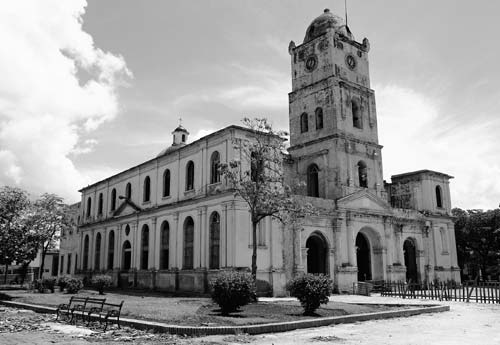
Iglesia de San José
Looming over Holguín to the north is the Loma de la Cruz (Hill of the Cross), named for the cross that has stood here since 1790. From here you can look out over the city and across the plains towards the mountain formations of the Grupo de Maniabon. To get there, climb the 450 or so steps that begin at the north end of Calle Maceo, 10 blocks north of Plaza San José, or drive via Avenida Capitán Urbino. Security guards are present 24/7.
Avenida de los Libertadores is lined with monuments to South American “liberators” and revolutionary heroes: Benito Juárez (esq. Aricoches), Simón Bolívar (esq. Cables), Máximo Gómez (esq. San Carlos), Antonio Maceo (400 meters west of Av. de los Internacionalistas), and Che Guevara (esq. Av. de los Internacionalistas).
Still manufacturing mechanized órganos pneumáticos (air-compression organs) in traditional manner, Fábrica de Órganos (Carretera de Gibara #301, no tel., Mon.-Fri. 7am-3pm, free), on the Gibara road about one kilometer east of General Marrero, provides a fascinating peek at age-old Cuban craftsmanship in rather Dickensian conditions.
Every May, the city bursts alive with Las Romerías de Mayo, when theater, music, and dance events explode around the city.
Salon 1720 (Frexes #190, e/ Manduley y Miró, tel. 024/42-1078) hosts live music each Friday and Saturday at 9pm.
You can schmooze with intellectuals at UNEAC (National Union of Cuban Writers and Artists, Libertad #148, tel. 024/46-4066, daily 8am-midnight), which hosts cultural events.
For 10-pin bowling, head to La Bolera (Habana, esq. Libertad, tel. 024/46-8812, daily 10am-1am, CUC1).
Teatro Comandante Eddy Suñol (Martí #111, tel. 024/46-3161), on Parque Calixto García, hosts ballet, classical, and theatrical performances.
You can catch a baseball game October-May at Estadio Calixto García (Av. XX Aniversario, tel. 024/46-2606).
It’s appropriate the Cuba’s main brewing city serves serious sudsters with draft Mayabe beer served in ceramic mugs at the German-style Taberna Pancho (Av. Dimitrov, tel. 024/48-1868, daily noon-11pm), next to Hotel Pernik, and Taberna Mayabe (Libertad, esq. Aguilera, tel. 024/46-1543, noon-6pm and 8pm-midnight).
Islazul’s open-air Cabaret Nocturno (tel. 024/42-5185, Wed.-Mon. at 10pm, CUC8 including one drink), a mini-Tropicana on the Carretera Central two kilometers west of town, is followed by the city’s top disco.
Timeworn crooners perform at the Casa de la Trova “El Guayabero” (Maceo #174, tel. 024/45-3104, Tues.-Sun. 11am-6pm and 8pm-1am, CUC1), on the west side of Parque Calixto García.
For contemporary sounds, the hot spots include the new Cabaret Salón Benny Moré (Maceo, esq. Luz Caballero, CUC2), with a nightly open-air show at 10:30pm. Midweek try the insanely packed Disco Cristal (Edificio Cristal, Manduley esq. Martí, Tues.-Thurs. 9pm-2am). On weekends it’s the Hotel Pernik’s hot-hot-hot Disco Havana Club (Fri.-Sun. 10pm-2am, CUC2).
All-in-one, the Casa de la Música (Libertad, esq. Frexes) has a medley of venues. Upstairs, musicians tickle the ivories of the Piano Bar Las Musas (daily 4pm-2am, CUC3); bands perform live downstairs in the air-conditioned Salon Santa Palabra (nightly 9pm-2am, CUC1-5); and rooftop Terraza Bucanero serves draft beer.
There’s even live jazz, at the Jazz Club (Libertad, esq. Frexes, tel. 024/47-4312, nightly 3pm-2am, CUC5). La Caverna The Beatles (tel. 024/45-3440, nightly 4pm-2am, 25 pesos) attempts to re-create Liverpool’s The Cavern, replete with life-size figures of the Fab Four.
Mid-January bursts with cultural events during Semana de Cultura Holguinera. Every May 3, a religious procession—Romería de Mayo—ascends to the top of Loma de la Cruz. The Festival Internacional de Ballet is held in November every even-numbered year, and the Fiesta Iberoamericana de la Cultura in October celebrates the Spanish heritage in music, dance, and theater.
My favorite private room rental is S Villa Liba (Maceo #46, esq. 18, Rpto. El Llano, tel. 024/42-3823, marielayoga@cristal.hlg.sld.cu, CUC25), a 1950s home replete with period furnishings. Two cross-ventilated rooms have private bathrooms. Erudite and gracious owners Jorge and Mariela (she gives massages) make wholesome meals served on a patio with a vine arbor and dipping pool. There’s secure parking.
S Hospedaje La Palma (Maceo #52, tel. 024/42-4683, CUC25-30) is another marvelous 1950s home in Southern California style. One of the two large rooms has a soaring beamed ceiling and a bathroom with piping hot water. The second room has more classical furniture. The place is festooned with art, including a dramatic terra-cotta bust of Che Guevara.
Casa de Rosa (Libertad #35, esq. 24, tel. 024/42-4630, rosama@telecristal.icrt.cu, CUC25) is a beautifully maintained, cross-ventilated 1940s home with pleasant furnishings and spirited artwork. It has two large rooms with clinically clean bathrooms. There’s parking.
You won’t regret staying at Casa de Don Santiago (Narciso López #25, Apto. 3, e/ Coliseo y 2da, tel. 024/42-6146, CUC20-25), on the second floor of a Soviet prefab apartment complex. The single bedroom has a TV, DVD, ceiling fan, but the main reason to stay here is your friendly hosts, who are educated conversationalists.
The Soviet-style Hotel Pernik (Av. Dimitrov, tel. 024/48-1011, www.islazul.cu, CUC25 s, CUC37 d low season, CUC30 s, CUC45 d high season), near the Plaza de la Revolución, has 202 pleasantly refurbished rooms (some have modems), plus a swimming pool and tennis court. The yin to the Pernik’s yang, and part of the same complex, the more intimate and similarly priced Villa El Bosque (tel. 024/48-1012, www.islazul.cu), 400 meters farther east, has 69 lovely new rooms in cabins, with modern bathrooms, in uninspired, sprawling grounds.
Holguín has seen an explosion of paladares in recent years, including Restaurant El Milano (Maceo #88, e/ Agramonte y Garajalde, tel. 024/42-5052, daily 11am-11pm), an Italian-run joint with de rigueur red-and-green decor and a menu featuring pizza, risotto, and lasagna (CUC5-8).
Paladar 1910 (Calle Mártires #143, e/ Aricochea y Cables, tel. 024/42-3994 or 5326-7098, Wed.-Mon. noon-midnight) specializes in roasts and seafood but has a broad-ranging international and criolla menu. Others to consider include: Los Almendros (Calle José A. Cardet #68, tel. 024/42-9652, daily noon-11pm), replicating a thatched country farmstead; El Ciruelo (Calle Victoria #108, e/ Aguilera y Frexes, tel. 5291-8414, daily noon-11pm), spicing things up with Chinese and even Japanese fare in a suitably oriental motif (think bonsai and bamboo); and Delicias Cubana (Calle Dositeo #78, e/ Agramonte y Garayalde, tel. 024/46-4397 or 5240-2800), open daily noon-11pm) for local and popular international dishes.
State-run Restaurante 1720 Las Parques (Frexes #190, e/ Manduley y Miró, tel. 024/45-8150, daily noon-10:30am) offers classical elegance in a restored colonial mansion. The menu includes onion soup, smoked salmon (CUC6), creole shrimp in brandy (CUC13), and paella (CUC5). Reservations recommended. Penny-pinchers can look out on Plaza Julio Graves at the atmospheric Restaurant 1545 (Maceo, esq. Luz Caballero, no tel., daily noon-4pm and 6pm-midnight), serving criolla fare for pesos. A dress code applies at both restaurants.
Taberna Pancho (Av. Dimitrov, tel. 024/48-1868, noon-10pm) serves set meals, including decent shrimp and pork dishes (CUC2.50-5, including two beers).
For views over town, ascend the Loma de la Cruz to the open-air Restaurante Loma de la Cruz (tel. 5285-5647, daily noon-9:30pm), although the menu is limited to criolla staples.
The La Begonia (daily 8am-2am) patio snack bar, on the west side of Parque Calixto García, is the unofficial meeting spot for foreign travelers.
The wait is worthwhile for ice cream at Cremería Guamá (daily 10am-10pm), on Plaza Julio Graves; 2.40 pesos buys you a full glass.
For baked goods head to Panadería Doña Neli (Manduley #285, daily 8am-8pm), two blocks south of Plaza Julio Graves. You can buy fresh produce at the mercado agropecuario at the east end of Coliseo.
Infotur (tel. 024/42-5013, holgdir@enet.cu, Mon.-Fri. 8am-5pm, Sat. 8am-1pm) has tourist information bureaus upstairs in Edificio Cristal and at the airport (tel. 024/47-4774, when flights arrive).
The post office (Máximo Gómez, e/ Aguilera y Arias) is on the east side of Parque Calixto García. DHL (Manduley, esq. Frexes, tel. 024/46-8254, Mon.-Fri. 9am-6pm, Sat. 8:30am-noon) has an office in the Edificio Cristal. Etecsa (Martí, e/ Mártires y Máximo Gómez, daily 8am-7pm) has international telephone and Internet service.
Banks include Bandec (on the south side of Plaza San José as well as on Maceo, esq. Aguilera), Banco Financiero Internacional (Aguilera, esq. Maceo), and Banco Popular (Maceo, e/ Aguilera y Arias, as well as one block south of the Villa El Bosque). You can change currency at Cadeca (Libertad e/ Martí y Luz Caballero, Mon.-Sat. 8am-5pm).
The unhygienic and dysfunctional Hospital Lenin (Av. Lenin, tel. 024/42-5302) is on the west side of town.
Consultoría Jurídica Internacional (Peralta #46, e/ Coliseo y Segunda, Rpto. Peralta, tel. 024/46-8299, Mon.-Fri. 8am-5pm, Sat. 8am-1pm) and Bufete Internacional (Manduley, e/ Frexes y Aguilera, tel. 024/46-8133) provide legal services.
Seeking a soothing massage after walking the streets? Mariela Gógora is renowned islandwide for yoga and massage classes and services. Contact her at Villa Liba (Maceo #46, esq. 18, Rpto. El Llano, tel. 024/42-3823).
The Aeropuerto Frank País (tel. 024/46-2512) is 10 kilometers south of town, on the Carretera Central. The domestic terminal is served by a bus from Calle Rodríguez, near the train station six blocks south of Parque Calixto García. Cubana (Edificio Cristal, tel. 024/46-8111, Mon.-Fri. 8am-4pm) and Aero Caribbean (Edificio Cristal, tel. 024/46-8556) fly between Havana and Holguín daily.
The Terminal de Ómnibus Inter-provinciales (Carretera Central #19, e/ 20 de Mayo e Independencia) is on the west side of town. Víazul buses (tel. 024/42-2111, www.viazul.com) stop in Holguín en route between Havana, Varadero, Trinidad, and Santiago de Cuba.
Buses to/from Guardalavaca and towns east of Holguín arrive and depart the Terminal de Ómnibus Municipales (Av. de los Libertadores, tel. 024/48-1170), opposite the baseball stadium. West and southbound trucks leave from Terminal La Molienda (Carretera Central y Comandante Fajardo, tel. 024/42-2322), on the west side of town. Bus #16 connects the Hotel Pernik with downtown.
Cuba’s main railway line serves Cacocum train station (tel. 024/32-7194), 15 kilometers south of town; an hourly bus connects Holguín’s Estación de Ferrocarriles (Calle Pita, tel. 024/42-2331), eight blocks south of Plaza Calixto García.
Trains depart Holguín for Guantánamo every second day at 2pm (CUC6.50); for Havana every third day (#16) at 1:10pm (CUC26); and for Las Tunas daily at 8:20am (CUC2.80). Trains depart Cacocum for Havana every third day at 1:20am (especial #2, CUC43) and 10:16pm (regular, #4, CUC26); and for Santiago de Cuba every third day at 7am (especial #1, CUC10) and 5:30am (regular, #3, CUC24.50).
You can rent cars through Cubacar (tel. 24/42-8196 at Hotel Pernik, tel. 024/46-8414 at the airport, com.renta.hlg@transtur.cu), Havanautos (tel. 024/46-8412, domestic terminal), Rex (tel. 024/46-4644, international terminal at Aeropuerto Frank País), and Vía (Cine Martí, tel. 024/42-1602).
Excursions are offered by Cubatur (Edificio Cristal, tel. 024/42-1679).
There are gas stations on Carretera a Gibara, on Avenida de los Libertadores, on Avenida de los Internacionalistas, and at the junction of the Carretera Central and circunvalación.
Cubataxi (tel. 024/42-3290) offers taxi service.
The Mirador de Mayabe (daily 10am-6pm, CUC2 entrance), high above the Mayabe Valley eight kilometers southeast of town, offers magnificent views. The facility includes a thatched restaurant and bar (daily 7am-9pm). The place draws locals on weekends. Islazul’s Villa Mirador de Mayabe (tel. 024/42-2160, carpeta@mmayabe.co.cu, CUC25 s, CUC37 d low season, CUC30 s, CUC45 d high season) has 24 nicely furnished hilltop cabinas and a swimming pool. There’s also a fully-staffed four-bedroom house—Casa de Pancho.
Adjoining, Finca Mayabe is an ersatz farmstead with turkeys, geese, and other farm animals, as well as a gallería—cock pit—where you can watch cockfights. Its claim to fame was a beer-loving burro called Pancho (1960-2002), who consumed over 45,000 bottles of beer before dying of cirrhosis. Pancho’s equally thirsty young sidekick Panchito keeps the tradition alive. He is given Monday off, presumably to sleep off his weekend hangover. Panchito lives in a stall next to the bar, appropriately named Bar Burro. Refrain from this awful practice!
Gibara (pop. 20,000), 28 kilometers north of Holguín, is a browbeaten, salt-encrusted fishing port that overlooks the Bahía de Gibara. It was a major sugar-trading port in colonial days, when it was known as Villa Blanca and colloquially as La Perla del Oriente (Pearl of the Orient). It has no shortage of intriguing colonial structures, though only remnants remain of the original 18th-century city walls. Its seafront promenade, the Malecón, boasts a patinated statue of Camilo Cienfuegos.
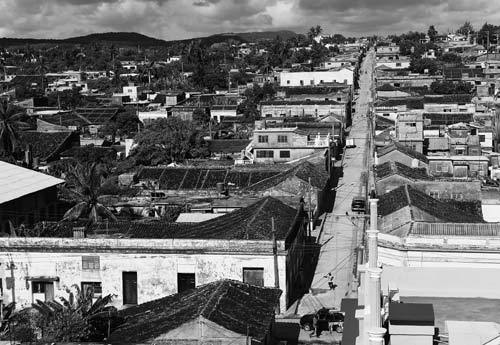
Gibara
The town was devastated by Hurricane Ike in November 2008 (more than 70 percent of homes in the area were damaged). The town has since been given a fresh coat of paint and is on its way to recovery, but at last visit it was still looking the worse for wear.
The streets rise steeply south and west of the main plaza. Follow Independencia west, uphill past charming little Plaza Colón, and turn right at Calle Cabada to reach the paltry ruins of Fuerte del Cuartelón, a 30-minute hike. Go for the view.
You can hire a boat to Playa Blanca, a beach on the east side of the bay (CUC5 round-trip), or drive the 15 kilometers northwest to Playa Caletones via a modern wind farm with five turbines.
To the southeast of Gibara is a flat-topped mountain, the Silla de Gibara (Saddle of Gibara), considered to be the hill described by Christopher Columbus when he landed on October 28, 1492.
The pretty main plaza is framed by African oaks and is pinned by a Monumento a Los Libertadores de la Patria, commemorating those who fought in the wars of independence. The restored Iglesia de San Fulgencio church, with Byzantine-style cupolas, dates from 1850.
The excellent Museo de Historia Natural (Luz Caballero #23, tel. 024/84-4458, Mon. 1pm-5pm, Tues.-Sat. 8am-noon and 1pm-5pm, Sun. 8am-noon, entrance CUC1, cameras CUC1, guide CUC5) displays stuffed animals and other natural history exhibits.
The Museo de Arte Decorativo (Independencia #19, tel. 024/84-4687, Tues.-Sat. 9am-noon and 1pm-5pm, Sun. 8am-noon, entrance CUC2, cameras CUC1), in a restored neoclassical mansion 50 meters southwest of the square, boasts period furniture and paintings upstairs.
Batería Fernando 7mo, one block east of the square, preserves an old fortress.
The open-air Centro Cultural El Colonial (Peralta, esq. Sartorio, CUC2) has live music Tuesday-Sunday nights.
Gibara is famed nationwide for its love of cinema. The Cine Jiba (Luz Caballero #17), on the main plaza, hosts Cuba’s annual Festival Internacional de Cine Pobre (International Low-Budget Film Festival, tel. 07/838-3657), drawing rising movie stars and producers to this unlikely venue each April. The festival is a big deal, and the town goes wild with carnival-like celebrations that include fireworks.
The standout is the antiques-filled S La Casa de los Amigos (Céspedes #15, e/ Luz Caballeros y Peralta, tel. 024/84-4115, lacasadelosamigos@yahoo.fr, CUC25), where the walls are covered in fabulous murals (some erotic). The two gorgeous air-conditioned bedrooms (choose a blue, orange, red, or green room) open to a patio with thatched bar-dining space and have fans, stone-lined walls, batik spreads and linens, and exquisite bathrooms. Lilian is your delightful host.
Next door, you’ll fall in love with La Casa de los Hermanos (Céspedes #13, e/ Peralta y Luz Caballero, tel. 024/84-4542, odalisgonzalezagurri@gmail.com, CUC20), where I enjoyed a stay in 2013. Odalis rents four antiques-filled rooms. S Villa Caney (Céspedes #36, e/ Peralta y Luz Caballero, tel. 024/84-4552, CUC20-25) is another colonial gem full of period pieces. It opens to a garden terrace with hammocks, palms, and a thatched restaurant—a delightful space! The owners rent two air-conditioned rooms with fans and private bathrooms with hot water.
Overhanging a tiny beach, Palmares’s modern Hostal Buena Vista (Calle Independencia Final, tel. 024/84-4596, CUC25 s, CUC35 d) has four ritzy rooms with antique repro furnishings. Nice locale, but a pity about the open sewer smells!
Newly minted in 2013, S Hotel Ordoño (Calle J. Peralta e/ Donato Mármol e Independencia, tel. 024/84-4448, dirección@hotelordono,.co.cu, CUC44 s, CUC56 d low season, CUC65 s, CUC82 d high season) shines after a complete restoration of a derelict family mansion. Beyond its columned lobby is an impressive restaurant. Upstairs are 21 beautifully furnished rooms on two levels (there’s no elevator; one room is on the ground floor). The master suite features an extravagant bathroom mural.
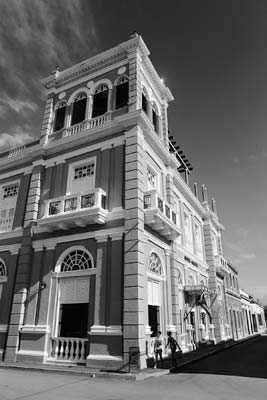
Hotel Ordoño, Gibara
The best of few eateries is the Restaurant Las Terrazas (corner Céspedes and Calixto García)—a.k.a. “Michael’s Place.” It exudes rustic ambience, not least thanks to its old fishing bar on the open-air rooftop terrace. It serves criolla fare and seafood.
The Hostal Buena Vista’s Restaurante El Faro (Calle Independencia Final, tel. 024/84-4596, daily 10:15am-8:15pm), with glass walls fronting the ocean, serves criolla and seafood dishes, including paella.
Six pesos (25 cents) will buy you a garlic shrimp dish at the no-frills hilltop Restaurante El Mirador (tel. 024/84-5259, daily noon-8pm), with views over town.
The bus station (tel. 024/84-4215) is at the entrance to town. Buses depart Holguín for Gibara twice daily.
Cubacar (Calle Independencia Final, tel. 024/84-4222) has a rental agency at Restaurante El Faro in Hostal Buena Vista.
There’s a gas station at the entrance to town.
This small town, 35 kilometers northeast of Holguín, is dominated by the now-defunct Rafael Freyre sugar mill. The central is the setting for what is touted as the Museo de Locomotora de Vapor (Steam Train Museum, tel. 024/85-0493, Mon.-Fri. 9:30am-11:30pm). Visitors find six engines (the oldest dates from 1882) in derelict sheds. Entry is officially by either of two steam-train excursions—“Choo Choo Train” (CUC10) and “Cuba Inside” (CUC7)—offered by Cubatur and Gaviota in Guardalavaca, but you might get lucky if you stop by.
The town (also known as Santa Lucía) lies a few kilometers inland of Bahía de Bariay. If you zigzag through Rafael Freyre and go past the central, the road north will take you to the bay and Playa Blanca, a gorgeous beach with a commemorative plaque to Columbus that declares this the “site of the first landing of Christopher Columbus in Cuba.”
Created in 2002 to honor Columbus’s landing, this 206-hectare park (tel. 024/43-3311, daily 9am-5pm, CUC8 entrance including cocktail) is within the broader Parque Cristóbal Colón. This meager facility features a re-created village—Aldea Aborigen—where reenactments of Taíno life take place, with Cubans in indigenous garb; an archaeological site with a small museum; and the uninspired Monumento al Medio Milenio, commemorating Columbus’s landing.
Horseback rides are offered (CUC4).
To get there, turn north at Frey Benito, four kilometers west of Rafael Freyre. The Rafael Freyre-Frey Benito road continues west to Gibara, passing the Silla de Gibara, or saddle-shaped mountain, that Columbus recorded during his visit: CUC2 buys you entry to trails at Campismo Silla, four kilometers west of Frey Benito. It also has horseback riding.
Campismo Silla de Gibara (tel. 5219-4557, CUC5 pp), enjoying a fabulous location at the base of a mogote, is a simple holiday camp with 42 basic cabins (some air-conditioned) with cold-water showers. It has a swimming pool, café, and horseback riding.
At Playa Blanca, the Hotel Don Lino (tel. 024/43-0308, reservas@donlino.co.cu, CUC25 s, CUC36 d low season, CUC 60 s, CUC80 d high season) looks over its own small beach. It has 36 pleasantly furnished air-conditioned rooms in bungalows (18 are ocean-view).
Two hotels are planned to be built in coming years.
Guardalavaca (the name means “Guard the Cow”) is a resort about 55 kilometers northeast of Holguín. The beaches are gorgeous. Scuba diving and snorkeling are excellent. Most hotels are all-inclusive and cater almost exclusively to package charter groups. It’s small fry compared to Varadero or Cayo Coco, and a stay here may come as a disappointment to sun-sea-and-sand-loving tourists who are expecting the scope of Cancún.

Guardalavaca
The original resort, comprising Guardalavaca proper, is at the twin-beach strip of Playa Mayor and Playa Las Brisas. Recent development has focused farther west at Playa Esmeralda, Playa Pesquero, and Playa Yuraguanal, midway between Guardalavaca and Rafael Freyre, where you’re out on a limb.
This museum (tel. 024/43-0201, Mon.-Sat. 9am-5pm, Sun 9am-1pm, entrance CUC2, cameras CUC5), on a hilltop seven kilometers east of Guardalavaca and two kilometers south from the highway, is on a large aboriginal burial site (almost 200 skeletons have been unearthed). A gallery surrounds the burial ground within a building where the skeletons lie in peaceful repose. Pre-Columbian artifacts are displayed. A life-size model indigenous village—Aldea Taína—has been re-created across the road (CUC5 additional) with an ensemble of locals dressed like Taíno who perform at noon Monday-Saturday.
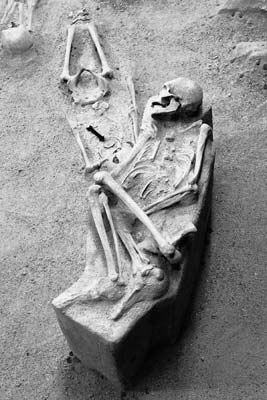
human skeleton at Museo Aborigen Chorro de Maíta
This huge flask-shaped bay, about four kilometers west of Guardalavaca, is fringed by mangroves and dry forest. The eastern headland is accessible via Las Guanas Sendero Eco-Arqueológico (daily 8:30am-5:30pm, CUC3), where trails lead to archaeological sites and Cueva Ciboney, a funerary cave with petroglyphs. Lookout towers provide a bird’s-eye view. An interpretive center offers introductions to the flora and fauna.
Acuario Cayo Naranjo (tel. 024/43-0132, daily 9am-9pm, CUC2 cameras, CUC5 videos) occupies a natural lagoon on the tiny island in the middle of the bay. Sea lions and dolphins perform acrobatics at noon. The hotels offer excursions.
Horseback riding is offered at Centro Hípico Rancho Naranjo (Playa Esmeralda) and Bioparque Rocazul (daily 9am-5pm, entrance CUC8, cameras CUC1, videos CUC2), a 1,487-hectare recreational facility on the west side of the bay. Trails lead through the scrub and mangroves, and to Finca Monte Bello (CUC16), a faux farm hosting rodeos (Mon., Wed., and Fri. 10:30am, CUC9 adult, CUC5 children). Rocazul also offers guided hiking.
Marlin Club Las Brisas (tel. 024/43-0774), at the east end of Playa Las Brisas, offers banana-boat rides, waterskiing, kayak and Hobie Cat rental, sportfishing, and catamaran excursions. Marlin Eagle Ray Dive Center (tel. 024/43-0316), at the west end of Playa Mayor offers scuba diving (CUC45 one dive) at 9am, 11am, and 2pm. There’s also a dive center at the Blau Costa Verde Beach hotel, at Playa Pesquero.
Gaviotatours offers a Locomotur steam-train ride (CUC49 adults, CUC30 children).
All accommodations are air-conditioned, with satellite TVs, telephones, and modern bathrooms.
Cubanacán’s all-inclusive Club Amigo Atlántico-Guardalavaca (tel. 024/43-0180, reserva@clubamigo.gcv.tur.cu) incorporates 747 rooms in four properties. Club Amigo Guardalavaca (CUC46 s, CUC72 d low season, CUC81 s, CUC122 d high season), 100 meters inland from the beach, has 234 standard rooms. Activity revolves around a huge swimming pool with a water slide, and there’s tennis and volleyball. The beachfront Club Amigo Atlántico (CUC46 s, CUC72 d low season, CUC81 s, CUC122 d high season) has more upscale “Tropical” rooms, though not all have ocean views. The contemporary Villas Club Amigo (CUC68 s, CUC96 d low season, CUC109 s, CUC158 d high season) has 136 rooms in gracious two-story villas around a swimming pool in landscaped grounds. Last but not least, Villas Guardalavaca (CUC68 s, CUC96 d low season, CUC109 s, CUC158 d high season) has 144 beachside cabinas including four mini-suites.
The nicest place is Brisas Guardalavaca (tel. 024/43-0218, www.brisasguardalavaca.com, from CUC75 s, CUC94 d low season, from CUC96 s, CUC120 d high season), on Playa Las Brisas. This four-star all-inclusive resort has 357 pleasantly furnished rooms, 80 mini-suites, and four junior suites and is divided into villa and hotel complexes with two large pools.
If you don’t mind a 20-minute walk to the beach, consider a room rental at Casa Vista La Mar in the community of Cuatro Caminos, on the main road about two kilometers east of Guardalavaca.
The following all-inclusive hotels are run by Gaviota (www.grupo-gaviota.cu) and include entertainment and water sports. The Sol Río de Luna y Mares (tel. 024/43-0030, www.meliacuba.com, from CUC150 s, CUC200 d low season, from CUC163 s, CUC220 d high season), managed by Spain’s Sol Meliá and comprising two adjacent hotels, has 564 rooms done up in eye-pleasing Caribbean pastels and set in beautifully landscaped grounds. Also managed by Sol Meliá, Paradisus Río de Oro (tel. 024/43-0090, www.meliacuba.com, from CUC277 s, CUC396 d) is a more upscale 300-room option with similarly lively tropical decor and an exquisite contemporary vogue. A highlight is its Japanese restaurant.
The 309-room Blau Costa Verde Beach (Playa Pesquero, tel. 24/43-3510, www.blauhotels.com, from CUC63 pp) is handsome within, despite its ungainly exterior and awkward layout. The vast freeform pool with swim-up bar is a nice feature. There’s not much to choose between the Blau and the similarly priced Hotel Playa Costa Verde (Playa Pesquero, tel. 024/43-3520, sales@playacostaverde.co.cu, from CUC63 pp), with 464 rooms and 16 suites.
Billed as a five-star (it barely meets three-star international standards), the delightful Hotel Playa Pesquero (tel. 024/43-3530) has a vast Asian-style lobby with fish ponds. The 928 junior suites (eight equipped for guests with disabilities) and 16 suites feature lively Caribbean colors and a contemporary neoclassical chic.
Top billing goes to the classy, 520-room S Riu Playa Turquesa (Playa Yuraguanal, tel. 024/43-3540, www.riu.com, from CUC150 s, CUC200 d). It has six restaurants, and seven pools are connected by cascading waterfalls.
Tops by far is the private S Restaurant La Maison (100 meters west of Playa Mayor, tel. 024/48-0839, daily noon-11pm), a paladar with an enviable hilltop position overlooking Playa Mayor. Great ocean views. Great food, including paella (CUC5) and lobster (from CUC12.50). And a lovely setting in a coralstone home with patio dining under an arbor.
State-run El Ancla (tel. 024/43-0381, daily 10am-10pm), atop a coral outcrop at the west end of Playa Mayor, specializes in seafood; it serves fish dishes for CUC8 and up (lobster costs a ludicrous CUC31).
Most hotels sell day and evening passes (CUC35-50), which include all-inclusive use of their restaurants and other facilities.
Guests in hotels at Playa Pesquero and Yuraguanal can escape to dine at Restaurant El Jagüey, a simple paladar serving genuine criolla fare alfresco.
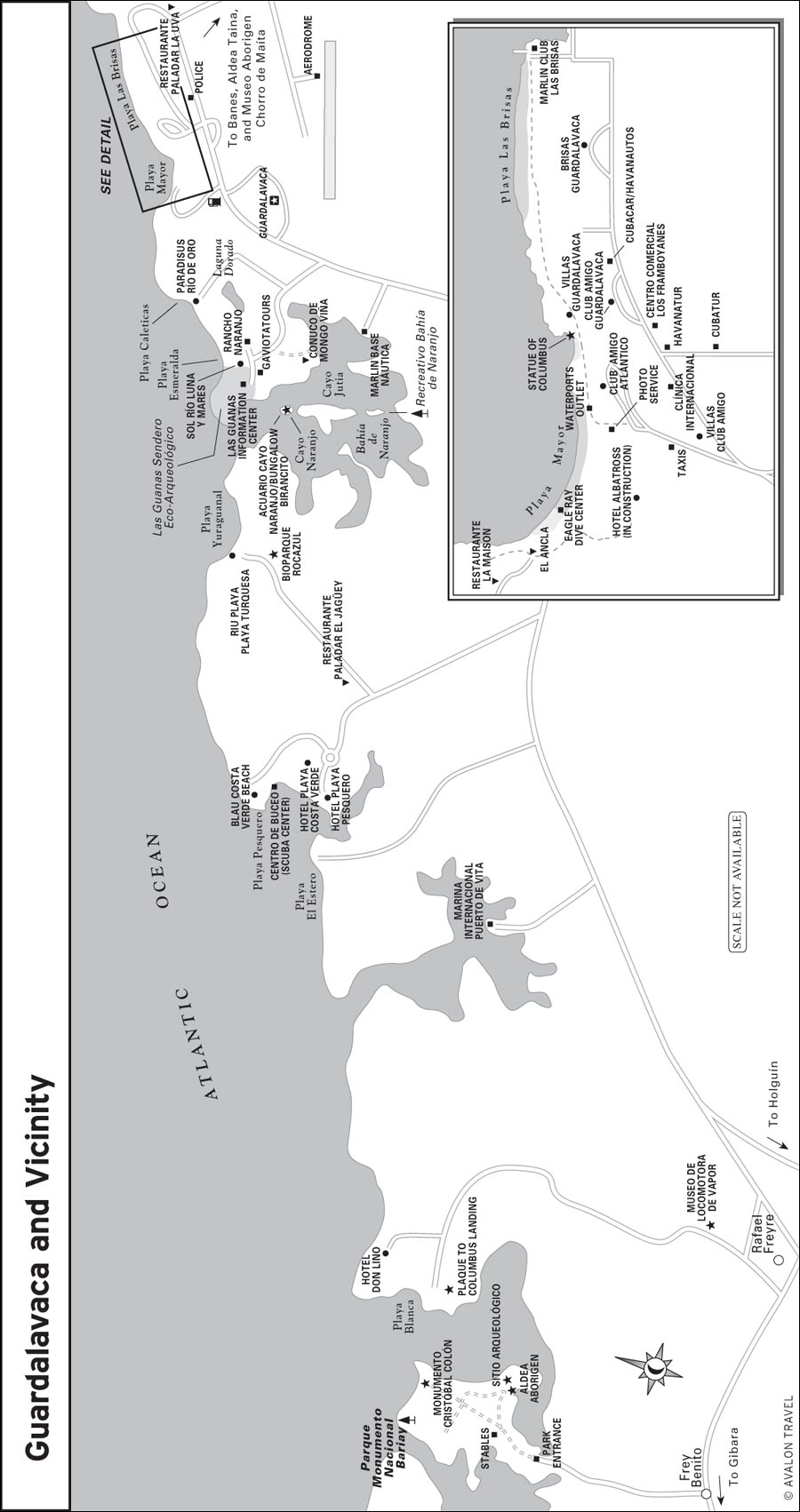
The post office and DHL service are in the Brisas Guardalavaca resort. International calls from hotels are expensive; use the minipuntos (telephone kiosks) roadside at Playa Mayor and Playa Esmeralda.
There’s a bank (Mon.-Fri. 8am-3:30pm, Sat. 8am-1pm) and Clínica Internacional (tel. 024/43-0312, 24 hours) outside Club Amigo Atlántico-Guardalavaca.
Guardalavaca has no airport. Vacationers on package tours land at Holguín.
Buses operate between Holguín and Banes, but service is unreliable. A taxi from Holguín will cost about CUC5 one-way.
You can rent cars from Cubacar (tel. 024/43-0389), adjacent to Club Amigo Atlántico-Guardalavaca.
Excursions can be purchased at hotel tour desks or direct with Cubatur (tel. 024/43-0170), 50 meters south of Centro Comercial Los Framboyantes; Havanatur (tel. 024/43-0406, noryuan@havanatur.cu), at the west end of Guardalavaca; or Gaviota (tel. 024/43-0903, travel.hog@gaviotatours.co.cu).
Marina Puerto de Vita (tel. 024/43-0445, marvita@enet.cu), one kilometer west of Playa Pesquero, has 38 slips.
Horse-drawn coches charge CUC3 for a tour around Guardalavaca (CUC15 to the acuario).
You can hop on and off Transtur’s Guardalavaca Beach Tour (CUC5), which plies between Guardalavaca, Acuario Cayo Naranjo, and other beaches. The Holguín Bus Tour (CUC15) departs Guardalavaca at 9:20am and Holguín at 1pm.
Bicycles and scooters (CUC13 one hour, CUC25 per day) can be rented at Vía Rent-a-Cartal. Rex (tel. 024/42-0476) has an office at Brisas Guardalavaca.
Taxis await custom west of Villa Turey, or call Cubataxi (tel. 024/43-0330).
The gas station is immediately west of town.
Banes (pop. 84,000), about 34 kilometers southeast of Guardalavaca and 70 kilometers northeast of Holguín, is a large provincial sugar town. This is the real Cuba, with all the sundry life that Guardalavaca lacks. For much of the past century, the town was run by the United Fruit Company, which owned virtually all the land hereabouts and had a now-defunct sugar mill called Boston (since renamed Nicaragua) five kilometers south of town. “El Panchito,” a 1888 steam locomotive, now stands idle in Plaza del Panchito, in the center of town.
Fulgencio Batista was born here in 1901. His future archenemies, Fidel and Raúl Castro, were born nearby at Birán. On October 12, 1948, Fidel married Mirta Diaz-Balart, daughter of the mayor of Banes, in the art deco Iglesia de Nuestra Señora de la Caridad, on Parque Martí (the marriage dissolved five years later but produced a son, Fidelito).
The Museo Indocubano (General Marrero #305, tel. 024/80-2487, Tues.-Sat. 9am-5pm, Sun. 8am-noon, CUC1, camera CUC5) exhibits a collection of more than 20,000 pre-Columbian artifacts, most importantly a small gold fertility idol wearing a feather headdress.
In 2013 it was announced that the Peninsula de Ramón, southeast of Banes, is to be developed as a major tourist resort with 10,000 rooms at Carmona, Caimán and Baracutey beaches.
Casas particulares include Casa Evelyn Feria Diesquez (Bruno Merino #3401-A, e/ Delfín Pepo y Heredia, tel. 024/80-3150, CUC20), with two upstairs rooms opening to a terrace. Each has private bathroom. The hostess is a delight. There’s secure parking. If she’s full, Evelyn will call around for alternative, such as Villa Luna (Marrero #347, tel. 024/80-2918, CUC25), a charming home whose owner, Eduardo, speaks English. He rents one room, which sleeps three people.
Buses operate between Holguín and Banes; the terminal is at Calle Los Angeles and Tráfico.
Fidel Castro was born on August 13, 1926, at Finca Las Manacas, at Birán, below the western foothills of the Altiplanici de Nipe, 60 kilometers southeast of Holguín. Castro’s father, Ángel, began leasing land from the United Fruit Company in 1910, farmed sugarcane to sell to the mills, and grew wealthy on the proceeds of his 26,000-acre domain. Eventually, he acquired forests, a sawmill, and a nickel mine, and was the most important man in the region. Fidel, however, has worked to downplay his social privilege and prefers to exaggerate the simplicity of his background. “The house was made of wood. No mortar, cement, or bricks,” he told Brazilian theologian Frey Beto in Fidel: My Early Years. In truth it’s a substantial house—clearly the home of a well-to-do man. The two-story house on wooden pilings with a cattle barn underneath is a replica—the original burned to the ground in 1954. The property also contained a slaughterhouse, repair shop, store, bakery, and other facilities.
In 2002 the Finca Las Manacas (tel. 024/28-6114, Tues.-Sat. 8am-4pm, Sun. 8am-noon, entrance CUC10, cameras CUC10, videos CUC10), which is guarded by MININT soldiers, opened to the public as a National Historic Site. A guide will accompany you as you’re shown the graves of Castro’s parents, Ángel and Lina (at my last visit, the site was being prepared to receive Fidel’s remains); the simple schoolhouse that Fidel attended (his desk is front row, center, of course); and the local post office and telegraph office. The huge main house has many original furnishings, plus Fidel’s personal effects (including his baseball glove and basketball) and the bed in which it is claimed he was born. (In After Fidel, author and former CIA analyst Brian Latell cites convincing evidence that Fidel, who was born illegitimate and not legally acknowledged by his father until he was 17, lived his first few years with his mother, the family housemaid, and apart from his father and his formal wife.)
From Holguín, take the Cueto road (Route 6-123). Turn south five kilometers west of Cueto to Loynaz Echevarría. Turn east (left) just beyond the central. The community of Birán is seven kilometers farther, and Finca Las Manacas is two kilometers to the north. You can also reach Birán from Palma Soriano, to the south, by a badly potholed road via Mella, a sugar town with an artists’ cooperative.
From the small town of Mayarí Abajo, 80 kilometers east of Holguín, a road climbs sharply via a rough, partially paved and often muddy road to a broad altiplano (plateau) high in the Sierra Cristal, where mists drift languidly through the pine forest good for birding (65 species). It’s a great place to beat the heat and for bird-watching and hiking, centered on Villa Pinares de Mayarí, an eco-focused hotel at the mountain peak of Loma de Mensura (995 meters), 20 kilometers south of Mayarí. Much of the region is enshrined in Parque Nacional La Mensura.
At Loma de Mensura, the Cuban Academy of Sciences’ Estación de Investigación Integral de la Montaña includes an Orquideario La Mensura (daily 8am-5pm, no tel., CUC2 payable in the hotel), an orchid garden, and the 2.4-kilometer-long Sendero La Sabina (CUC6) self-guided nature trail, which is named for a local juniper species.
Two kilometers north of the Orquideario is La Plancha, another lovely garden set amid eucalyptus; it was ravaged by Hurricane Sandy in 2012 and closed for restoration at last visit, as was Finca Los Exóticos (8 km west of the Pinares road), where elk, nilgai, and deer are bred (originally for the hunting pleasure of the Communist elite). Unfortunately, EcoTur is planning arrow-hunting. Four rooms for rent are being prepared.
The high point of the altiplano is this not-to-be-missed site (daily 8:30am-5pm, c/o EcoTur, tel. 5408-8452, aliomar@hlg.sld.cu, CUC5), 17 kilometers north of Villa Pinares de Mayarí. The salto is a twin waterfall (120 and 140 meters, respectively). A mirador offers sensational views of the cascade and forested river canyon, and far out to the Atlantic. It has a delightful restaurant in a garden of ferns and poincianas. You can hike two trails: One descends to the base of the falls, and the second leads to the top, with natural pools atop the plunge.
Casa de Elin y Ilsïa (Calle Moncada #89, tel. 5291-0845, CUC20-25 including breakfast), 200 meters south of the Cupet gas station in Mayarí, is a delightful casa particular. Stone walls enhance the pleasing effect in the two air-conditioned guest rooms (one upstairs), each with private bathroom. Meals are served in a thatched rancho in the garden. There’s secure parking. An alternative is Casa Don Vicente (Calle Juan Vicente Loma #50, tel. 024/50-1316).
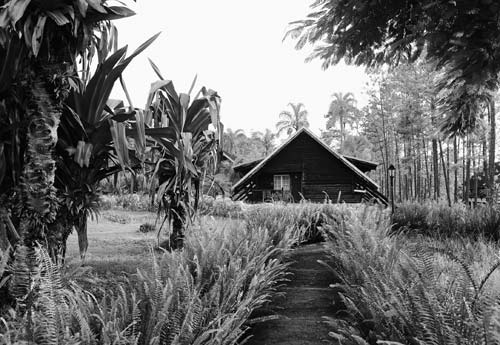
cabin at Villas Pinares de Mayarí
At 680 meters above sea level, Villa Pinares de Mayarí (tel. 024/50-3308, commercial@vpinares.co.cu, CUC26 s, CUC32 d low season, CUC30 s, CUC40 d high season) is a rustic eco-resort operated by Gaviota. It has 29 spacious yet rustic wooden one-, two- and three-bedroom cottages, all with private bathrooms. There’s a swimming pool and restaurant.
This 42-square-kilometer cay (CUC10 entrance), 18 kilometers north of the coast highway, is separated from the mainland by a hair’s-breadth waterway. Its ecosystems range from mangrove swamps to evergreen forests harboring endangered species, including jabalí (wild boar), plus exotic animals—ostrich, zebra, giraffes, and camels, etc.—originally imported for the hunting pleasure of top Communist officials, for whom Cayo Saetía was once a private vacation spot.
One-hour jeep safaris (CUC9) and horseback riding (CUC6 per hour) are available; spotting the wildlife virtually requires a safari with guide. There are superb white-sand beaches beneath cliffs.
If driving, note that many maps show a nonexistent road direct from the Carretera Costa Norte to Cayo Saetía. The real road leads to Felton, a T junction with an unmarked turnoff to the right for Cayo Saetía.
Villa Cayo Saetía (tel. 024/51-6900, comercial@cayosaetia.co.cu, from CUC49 s, CUC60 d low season, CUC54 s, CUC65 d high season) has 12 handsome yet rustic cabinas and suites with satellite TVs. The eyes of animals that wandered between crosshairs glower eerily as you dine in the restaurant.
Ranchón El Cristo (daily 9am-4pm) sits on stilts atop the beach; lunch is included with your visit. Snorkeling (CUC15) and kayaking (CUC6) are offered.
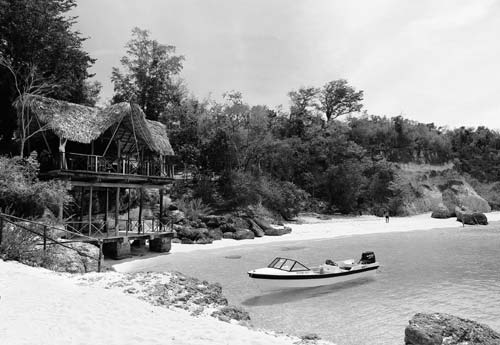
Ranchón El Cristo
East of Mayarí, the Circuito Norte coast road leads past a series of port towns that rely on the mineral ore industries. Tall chimneys belching out smoke announce your arrival at the coastal town of Moa. The town is smothered with red dust from the nearby processing plants. It has been claimed (probably in jest) that Cuban engineers would rather sacrifice their careers than work here. Nonetheless, Moa has the only accommodations in the many lonesome miles between Mayarí and Baracoa. Passing through Sagua de Tanamo (30 kilometers west of Moa), note the Caballo de Troya (Trojan Horse), a homemade armored carrier used by revolutionaries against Batista’s troops.
Two kilometers east of Moa you’ll pass Empresa Comandante Ernesto Che Guevara, a huge smelting plant guarded by a statue of Che towering over the gates. The environment has been hammered and sickled into a grotesque gangue pitted with pestilential lagoons. Gnarled, splintered trees add to the dramatic effect, like the aftermath of a World War I bombardment.
Photography is prohibited—one suspects more because the government is embarrassed by the horrendous blight than for any strategic reason!
Islazul’s Soviet-era Hotel Miraflores (Av. Amistad, tel. 024/66-6103, jcarpeta@miraflores.co.cu, CUC18 s, CUC23 d year-round) has 148 modestly furnished rooms, plus a swimming pool, restaurant, disco, and car rental.
Cubana (tel. 024/66-7916) flies from Havana on Monday to Moa’s Orestes Acosta Airport (tel. 024/66-7012), three kilometers east of town.
A bus departs Holguín daily for Moa, from where camiones and jeep colectivo taxis operate to Baracoa (70 kilometers farther east).
There’s a gas station one kilometer west of town.